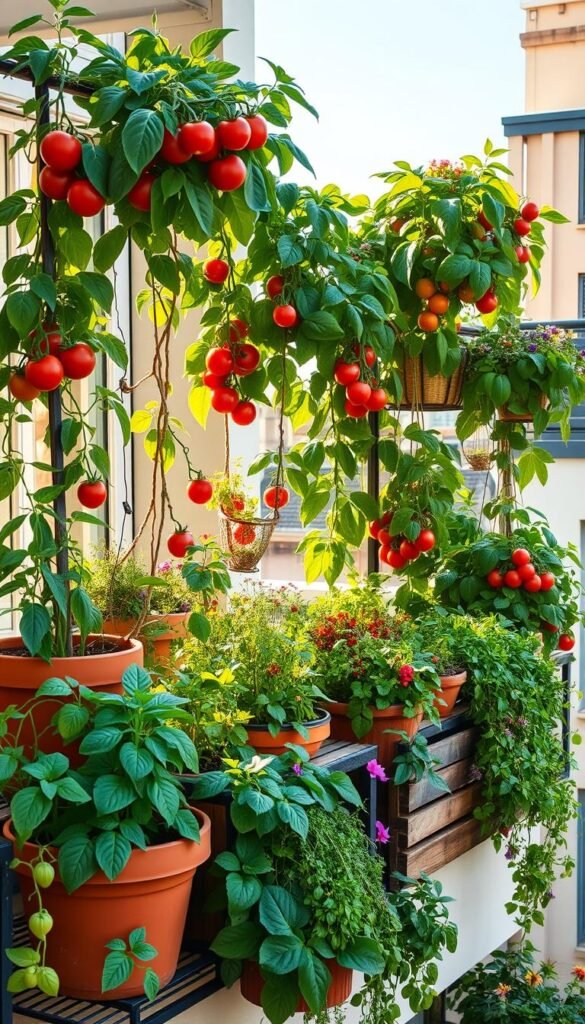Imagine stepping outside to pluck fresh herbs for dinner or snack on sun-warmed cherry tomatoes grown just steps from your kitchen. You don’t need sprawling beds or expert skills to create this delicious reality – your elevated outdoor area holds untapped potential.
Urban cultivation lets you work with what you have. Compact pots and clever layouts turn railings and corners into productive zones. Even first-time growers find success with leafy greens like spinach, aromatic basil, and compact pepper varieties perfect for confined areas.
This approach offers more than just convenience. Watching seeds become salad ingredients creates pride and connection to your food. You control what goes into your soil, ensuring chemical-free harvests packed with flavor and nutrients.
We’ll show you how to choose vessels that breathe, pair crops with sunlight patterns, and troubleshoot common issues. With these strategies, you’ll maximize every inch while avoiding overcrowding – the secret to healthy roots and abundant yields.
Introduction to Balcony Container Gardening
Have you ever considered turning your balcony into a lush, edible oasis? This approach lets you grow vibrant greens and juicy tomatoes where you least expect them. Unlike traditional methods, you’re not limited by poor soil or shady yards. Instead, you create the perfect conditions right outside your door.
Discovering the Benefits of Container Gardening
Complete control over your setup means healthier plants and tastier results. Choose soil packed with nutrients, adjust drainage, and skip backbreaking weeding. Pests? They’re easier to manage when your crops sit waist-high.
Another perk: your harvest stays clean. No dirt clumps on carrots or grit in lettuce leaves. Plus, you’ll water and check growth daily without trekking across a yard. It’s gardening made simple.
Why Your Balcony is the Perfect Garden Space
That sunlit corner by the railing? It’s prime real estate for peppers and herbs. Most balconies get 6-8 hours of light – ideal for veggies. Too windy? Move pots behind glass doors temporarily.
Vertical planters double your growing area without crowding the floor. Hanging baskets of strawberries or wall-mounted herb racks make every inch count. You’ll be amazed how much fits in a 10-foot space.
Choosing the Right Containers and Quality Soil

Your plants’ home matters as much as sunlight and water. The perfect combination of containers and soil creates a thriving ecosystem for roots to spread and nutrients to flow. Let’s break down what works best for your space.
Understanding Container Materials and Sizes
Plastic pots win for ease: lightweight, affordable, and moisture-retentive. Opt for food-safe versions to protect edible plants. Ceramic adds style but demands careful handling – their weight and fragility matter in windy spots.
Fabric options excel at airflow, letting roots “breathe” while preventing waterlogging. Just water more often – they dry faster than other materials. Always match container size to your plant’s needs: herbs thrive in 6-inch pots, while tomatoes need 18-inch homes.
| Material | Pros | Cons | Best For |
|---|---|---|---|
| Plastic | Lightweight, retains moisture | Less decorative | Beginners, herbs |
| Ceramic | Stylish, stable | Heavy, fragile | Decorative setups |
| Fabric | Superior aeration | Frequent watering | Root vegetables |
Selecting a Soilless Potting Mix
Garden dirt suffocates roots in pots. Instead, use soilless mixes with peat moss or coconut coir for water retention. Perlite ensures drainage, while vermiculite holds nutrients. These blends stay fluffy season after season.
Always check for drainage holes – 1/4-inch openings prevent soggy roots. Small pots need 3-6 holes; larger ones require 6-8. For more tips on setup, explore our container gardening basics guide.
Container Gardening for Beginners: Grow Veggies on a Balcony
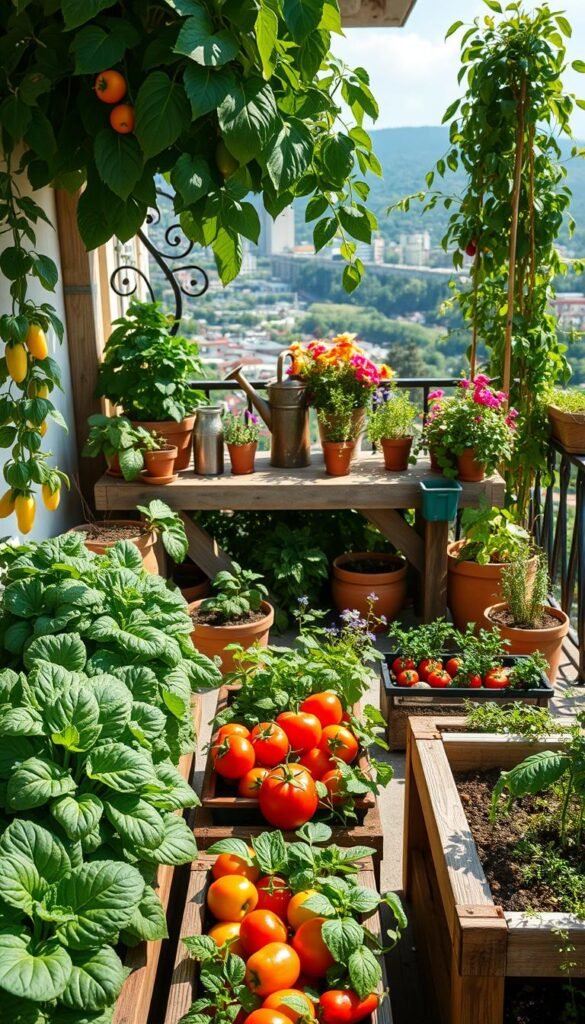
Transform your elevated space into a thriving edible retreat through strategic planning. Success begins with matching your plants’ needs to the right-sized homes and preparing them for peak performance.
Steps to Start Your Container Garden
Begin by measuring root depth requirements. Leafy greens flourish in 6-inch pots, while tomatoes demand 18-inch homes. Use this quick reference table to simplify choices:
| Container Size | Depth | Best Plants | Water Needs |
|---|---|---|---|
| 5-gallon | 12-14″ | Tomatoes, peppers | Daily checks |
| 3-gallon | 8-10″ | Bush beans, herbs | Every 2 days |
| 12″ wide | 6-8″ | Lettuce, radishes | Light misting |
Setting Up Containers for Optimal Growth
Layer gravel or broken pottery at the base for drainage before adding soil. Leave 1-2 inches below the rim to prevent spills. Position sun-loving crops where they’ll get 6+ hours of light.
Try pairing vertical growers with spreading varieties. A tomato cage surrounded by basil creates natural pest protection while saving space. For compact vegetables, use window boxes along railings.
Install trellises during planting to avoid damaging roots later. Water thoroughly after setup, and watch your edible oasis come alive!
Plant Selection: Veggies, Herbs, and Flowers for Your Balcony
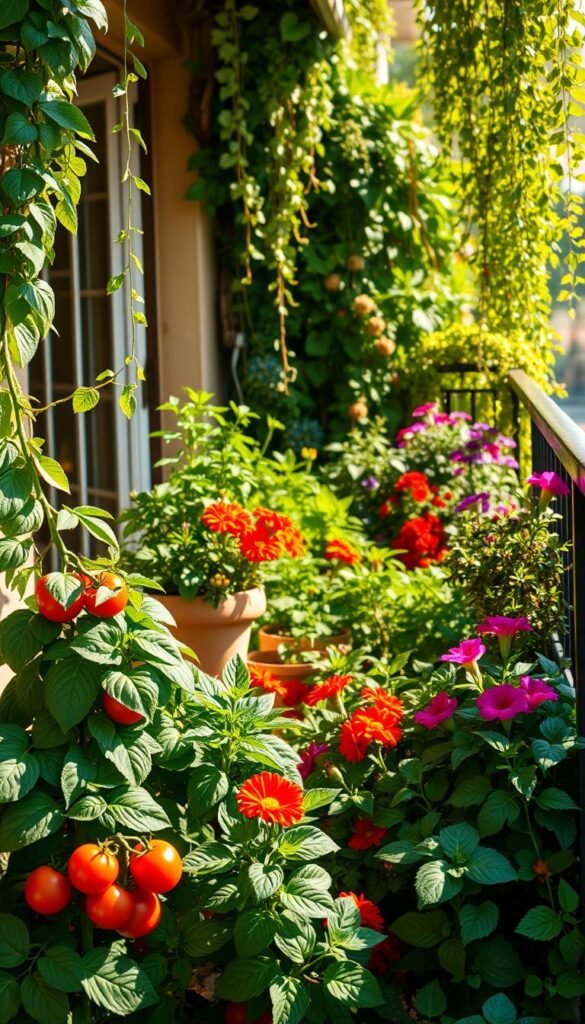
Your balcony becomes a living pantry when stocked with the right edible treasures. Focus on crops that deliver big flavors without demanding excessive space. Mix practical picks with colorful blooms to create a vibrant, productive ecosystem.
Top Veggies for Compact Spaces
Leafy greens like kale and spinach thrive in shallow pots, offering multiple harvests from one planting. For quick wins, try radishes – ready in 25 days! Determinate tomatoes (bush types) stay manageable while producing juicy fruits all summer.
| Vegetable | Container Size | Days to Harvest | Special Tip |
|---|---|---|---|
| Cherry Tomatoes | 5-gallon | 60-70 | Use cage support |
| Arugula | 8″ deep | 21-35 | Harvest outer leaves |
| Dwarf Peppers | 3-gallon | 65-80 | South-facing spot |
Flavor Boosters & Pollinator Magnets
Basil and oregano elevate dishes while repelling pests. Add nasturtiums – their edible flowers attract bees and brighten salads. Mint grows vigorously in confined spaces, but keep it solo to prevent takeover.
Pair purple sage with red lettuce for visual drama. Lemon balm adds citrusy zing to teas and doubles as a natural air freshener. Remember: flowers like petunias aren’t just pretty – they lure beneficial insects that protect your food crops.
Optimizing Watering, Drainage, and Fertilization
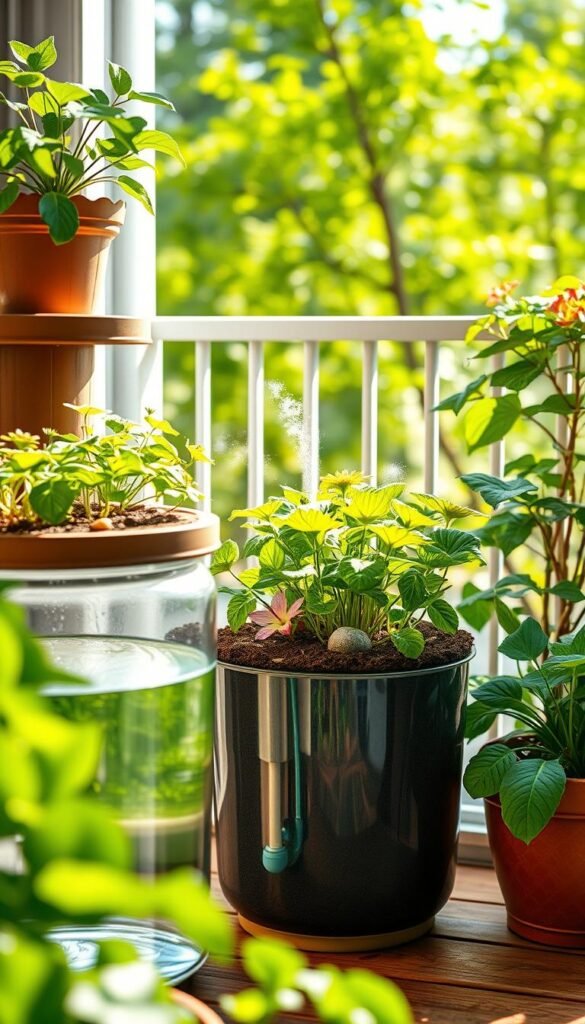
Keeping your plants thriving requires mastering three essentials: water flow, soil moisture, and nutrient balance. Small spaces demand precision – overwater once, and roots might drown; skip feeding schedules, and yields drop. Let’s explore how to ace these elements for vibrant growth.
Tips for Proper Drainage and Moisture Management
Water plants deeply until liquid escapes through drainage holes – this encourages strong root systems. Morning sessions work best, giving leaves time to dry before cooler evenings. Small pots may need daily attention in summer, while larger ones hold moisture longer.
Elevate containers using pot feet or bricks to prevent standing water. Mix perlite into soil to improve drainage for moisture-sensitive crops like rosemary. Check soil daily: push a finger 2 inches deep – if it’s dry, it’s time to water.
Fertilizer Choices: Quick-Release vs. Slow-Release
Feed your green friends smartly with this strategy:
| Type | Activation Time | Duration | Best For |
|---|---|---|---|
| Slow-Release Granular | 2-4 weeks | 3-6 months | Busy gardeners |
| Water-Soluble (e.g., Miracle-Gro) | 24-48 hours | 2-4 weeks | Quick nutrient boosts |
| Organic Options | 1-2 months | Season-long | Chemical-free setups |
Start with slow-release pellets mixed into soil during planting. Switch to liquid fertilizers like Miracle-Gro 24-8-16 for leafy greens after 8 weeks. For tomatoes, use balanced 18-18-21 formulas when flowers appear. Always follow package instructions to avoid root burn.
Creative Space Optimization and Balcony Layout
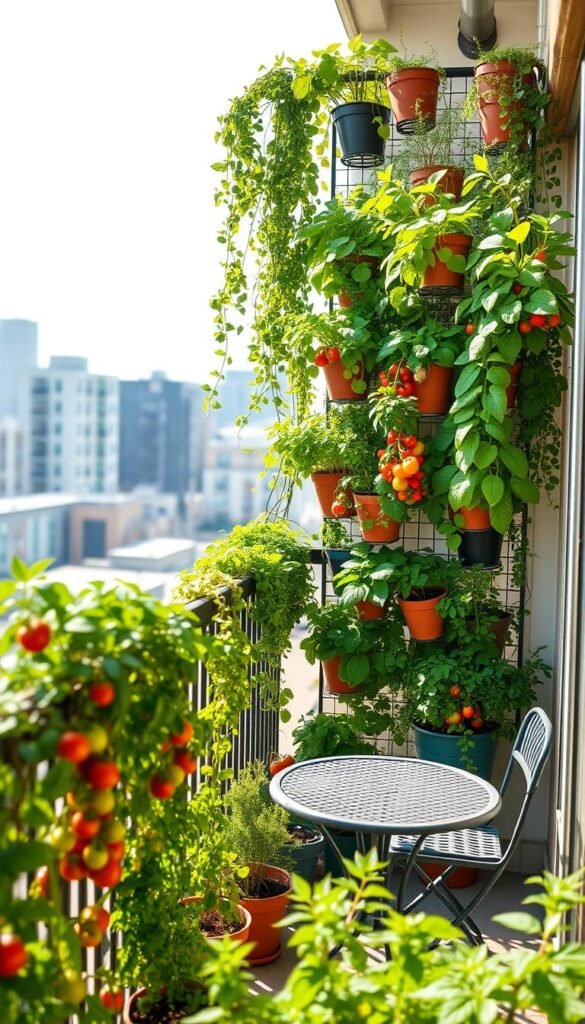
Unlock hidden growing potential by reimagining your vertical surfaces. Walls, railings, and overhead areas become prime real estate when floor space runs tight. This approach lets you triple production without tripping over pots.
Sky-High Solutions for Compact Areas
Hanging baskets transform dead air into strawberry factories. Position them near seating areas where you’ll naturally spot ripe berries. Rail planters work magic for trailing cherry tomatoes – their cascading vines turn metal bars into edible curtains.
Keep herbs like thyme and oregano within arm’s reach of your door. You’ll snip sprigs while waiting for coffee to brew. This strategic placement turns care into quick, daily habits rather than chores.
| Vertical Method | Best Plants | Space Saved | Maintenance Level |
|---|---|---|---|
| Hanging Baskets | Strawberries, trailing nasturtiums | 2-3 sq ft | Medium (daily watering) |
| Rail Planters | Cherry tomatoes, bush beans | 4-5 sq ft | Low (every 3 days) |
| Tiered Shelves | Lettuce, radishes, basil | 6-8 sq ft | High (rotation needed) |
| Trellis Systems | Cucumbers, pole beans | Floor space only | Medium (weekly training) |
Repurpose old items creatively – whiskey barrels host dwarf citrus trees, while window boxes lining rails grow peppery arugula. Always check weight limits before installing heavy planters, especially on older buildings.
Arrange taller plants against walls to avoid shading smaller ones. Rotate pots weekly so all sides get sunlight. With smart planning, your compact oasis becomes both functional and Instagram-worthy!
Designing Your Balcony Garden: Style Meets Function
Your elevated outdoor space deserves both beauty and purpose. Start with clean lines and multi-functional pieces – a foldable bistro set doubles as a dining spot and plant stand. Add pops of color with marigolds or zinnias in vibrant pots that complement your home‘s exterior.
Smart Decor That Works Hard
Mix edible and ornamental plants for visual drama. Purple basil pairs beautifully with pink petunias, while trailing cherry tomatoes soften metal railings. Use wall-mounted planters for herbs like thyme, saving floor space for taller crops. This approach keeps your garden productive without sacrificing charm.
For a standout feature, try a compact patio kitchen. Repurpose a rolling cart as a herb station with built-in storage for tools. Include our top vegetables for tight spaces in window boxes – their lush growth adds natural privacy screens.
Remember: simplicity wins. A trio of matching pots with staggered-height plants creates cohesion. Add solar lanterns for evening ambiance. With these tips, your balcony becomes an extension of your living area – fresh, functional, and utterly inviting.

